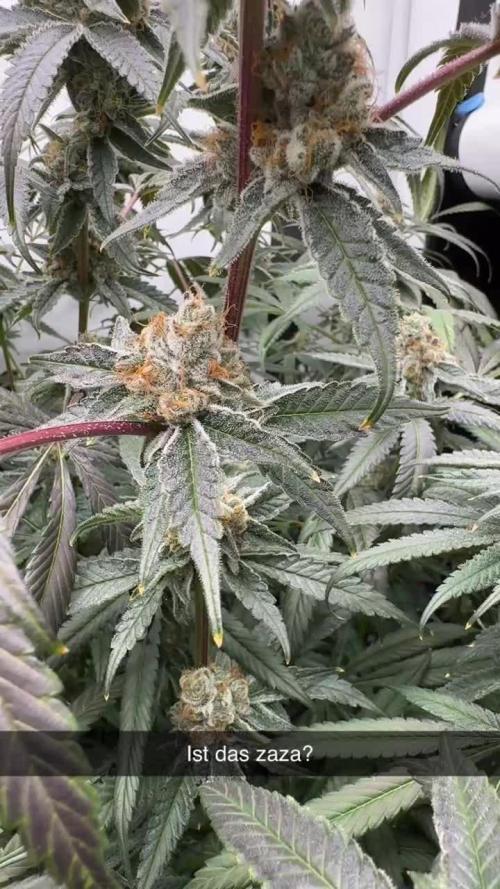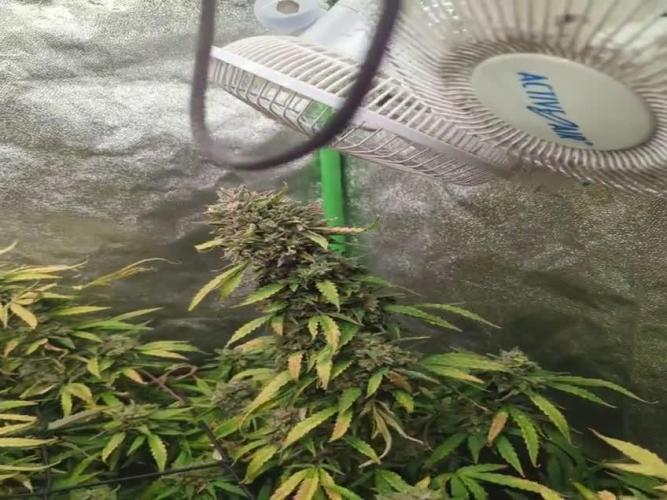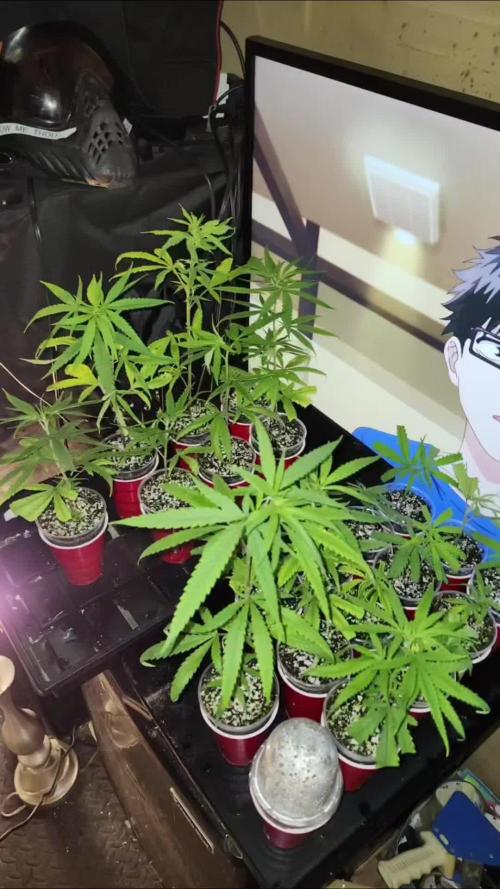The Grow Awards 2026 🏆 



























Likes
Comments
Share


@QixxGrows
Follow
Using 2 seeds in a luke warm water shotglass. Placing in cupboard to germinate.
Day1: Nothing yet
Day2: One of the seeds started to sprout. Showing it's sexy little tail. I'll monitor the growth in the next 24hrs and then decide whether she's ready for the sproutling pot or not.
Day3: Tails were looking pretty good - forgot to take a photo :/ roughly 1cm for one of them, which is the one that I decided to plant. It really hurt when I chucked the other seed, but I really only need one plant. Soil mix for the sproutling: Coco Coir - 70%, Vermiculite - 15%, Perlite - 15%. I also added Greenhouse Feeding "BioGrow" and Mycorrhiza. The picture was taken from my RPi + Cam setup that will be taking 2 photos/min. I'll post the timelapse at the end of the day.
Day4: Running the whole day in the tent with ventilation running minimally. Light only at 20%. No action, so I deleted all the pictures except for the last one taken before the lights went out.
Day5: No activity above the soil level. Probably spent the whole day focusing on root growth.
Day6: At around 09:20 I watered again and with this uncovered the first signs of life! The rest of the day was mostly uneventful - until the evening. Roughly 2hrs before lights-out she started to move.
Day7: Things starting to look really good :)
Likes
17
Share


@Young_agronomist
Follow
09.03.2023-первый день пятой недели начался с сломанного главного стебля ((
Увы спасти его не удалось пришлось сделать “топпинг“.
10.03.2023- После поломки стебля “видимого“ стресса не испытал.
По показаниям ppm стока стал активно пить воду (3 литра каждый день)и есть орехи .
На этой неделе я начну давать 750 ppm
12.04.2023-взрыв роста за ночь !!
Начинаю видеть предварительные цветы , думаю это последняя неделя вегетации(ей уже тесно в палатке )
Перевел на новое питание greenhouse feeding short flowering , сделав флаш новым раствором пока сток не сровнялся с входом
Ppm 700 ph6.0
13.04.2023- Продолжает сильно растягиваться (особенно малышка , которой был сломан ствол заметно быстрей растет , ветки толстеют .Видимо перелом основного стебля направил соки в побочные ветки 👌🏻мне повезло 😂😂) обе пьют 3 литра в день ppm 700 ph6.0
14.03.2023- у девушке что поменьше обнаружил легкий ожог орехами , после замера ppm он показал 1100 . Принято решение сделать флаш раствором с маленьким содержанием Орехов , после чего ppm стал 600.
Вечером этого дня срезал пару старых лопухов затемняющим свет .
15.03.2023- Этих девочек не остановить ! Рост каждый день , палатка полностью заполнена . Со дня на день она начнет цвести.
Добавил лампу на 25w для более кустистой части (девушка без топпинга).
Likes
58
Share


@420DeepGrow
Follow
Gracias al equipo de AnesiaSeeds, Marshydro y XpertNutrients sin ellos esto no sería posible
💐 🍁Pink Matcha Slush: es un híbrido con una ligera dominancia índica (60% índica) que ofrece altos niveles de potencia y un aroma increíblemente delicioso. La cepa tiene el subidón perfecto de efectos índica y sativa, y trae consigo una gran potencia que puede dejarte completamente anonadado si no tienes cuidado con la dosis.
El subidón es rápido y potente, con una euforia cerebral vertiginosa. Te sientes concentrado, sociable y lleno de energía.
Es una planta de crecimiento veloz cuando empieza a florecer, llegando a alcanzar una altura de 100-120cm en interior, las plantas pueden alcanzar hasta 2m de altura en exterior, proporcionando una gran cantidad de rendimiento
Los efectos energizantes y el increíblemente alto contenido medio de THC del 31% hacen de Pink Matcha Slush una valiosa variedad terapéutica para su uso contra el estrés crónico, los cambios de humor, la depresión, la fatiga crónica y el TDA/TDAH.
🌻 🚀 Consigue aquí tus semillas:
https://anesiaseeds.com/es/product/pink-matcha-slush/
💡 Mars Hydro TS 3000, como la lámpara de cultivo LED más grande de la serie TS, ofrece suficiente cobertura para un área de 4 × 4 pies con un precio asequible y rendimientos de calidad; a cambio, se puede aplicar tanto al cultivo doméstico como al cultivo comercial.
Potencia - 450w
Cobertura Vegetal – 5×5 pies
Cobertura de flores - 4 × 4 pies
La opción abrumadora para la mayoría de los productores que la aplican en tiendas de campaña.
Consigue aqui tu lámpara:
https://marshydro.eu/products/mars-hydro-ts-3000-led-grow-light/
📆 Semana 10:
Última semana de esta maravilla de la naturaleza, ha quedado limpia y con unos cogollos duros y llenos de resina.
Defoliacion para una mejor penetración de la luz en la parte baja de la planta.
Una semana de lavado de raiz a base de agua de manantial y al secadero.
Likes
18
Share


@berlinbeginner
Follow
High temperatures and nutrient burn. At this point i have no idea what i am doing. Every now and then SD2 and SD3 release typical weed smell but apart from that no other smell. The stems upon rubbing and touching smell like cinammon,cloves and orange zest.It reminds me of fanta drink.
Processing
Likes
8
Share


@Salgeezi
Follow
Found these seeds helping my boss trim his outdoor plants. He had clones and unsure of the 3 diff strains. All we know is there something to do with kush.
Anyways I decided to start up a few and hopefully be successful with at least 1 lady to fill my 2x2 tent.
I think I will try main-lining with the 1 lady. Never had the guts to try it on 4 plants so this is the perfect opportunity.
I am currently using a No name blurple light I had lying around. Going to build a bridgelux led custom light for it soon. Just need to order a driver and a few strips
EC is at 0.4 this week. Don't remember the numbers for amount of nutes used
Likes
22
Share


@MonsieurDeLaRuche
Follow
D97 F50: what a week!!! I can't believe it, the plants are more and more fragrant, the flowers are bigger and bigger... I expected less than that!
I started the flush with simple osmosis water, corrected with a PH of 6.1! I managed to increase the EC from 2.1 to 1.3, with about 4 liters per plant!! I was able to remove the excess water in the tank using a pump! I'm aiming for an EC between 0.1 and 0.5 for half of week 9, before letting them dry on the foot.
In any case, there are fewer seeds in my flowers than I thought, I tried to remove a few seeds with tweezers, it worked for a few plants but the code red #1 didn't like it... some pieces of flowers dried a little and some trichromes matured faster!! I'm not touching anything anymore
smells:
Papaya Bang Bang #1: smells of exotic fruit candies, especially papaya, very deep and addictive!! a banger
LA Vanilla cake #2: smell of gas with ripe fruits, very cali gelato
Papaya bang bang #2: smell of exotic fruits on a very earthy background, a little og, it's not really what I was looking for but it looks interesting! I think it will be round in the mouth
cherry gar see ya #4: smell of exotic fruit compotes on a very fresh background!!
white runtz x Hollywood: a banger!! a very resinous runtz smell, almost rosin, with smells of lemongrass, ginger... I've never smelled that in my life!!
code red #2: smell of tangy strawberry, simple, not so many smells in the background, almost a little citrus
Code red #1: a banger too! a smell of strawberry syrup, cream, sugar, I can't take my nose off when I smell it
B-45: smell of citrus, grapefruit, with a bug background that I love
LA Vanilla Cake #1: very cali, gas, good gelato too, but without fruits
no TCO for the last two weeks, or very light! I'll give you the recipe anyway
in my flowering TCO, I put:
- kelp hydrolysate
- epsom salt
- bat guano
- mealworm guana
- castor bean shell ash
- palm ash
- vermicompost
- blackstrap molasses
- elycitor
-Yeasts Saccharomyces Cerevisiae
Bottom right: LA vanilla cake #2
Bottom middle: Code red #2
Bottom left: Papaya bang bang #1
middle right: cherry gar see ya #4 clone
middle: white runtz x Hollywood
middle left: Papaya Bang Bang #2
Top right: Code red #1
Top middle: LA vanilla cake #1
Top left: B-45
Likes
14
Share


@Jays_Not_Here_Man
Follow
The Runtz auto girls are doing 😊. They have settled in and are fattening and stacking nicely. They are only about 16-18 inches total, but have some nice fat buds, should be some good weight.
They are starting to develop some frost, but are very greasy to the touch 🤤 Trying to keep them in a sweet spot so they keep developing. RH around 55-58 % and Temps between 77-80 degrees. They are in week 8 now, and suggested harvest is about 70-75 days… Happy Gardening 🇨🇦👊❤️🌱
Likes
24
Share


@TheIceCreamParlour
Follow
This week has been all about the trichomes! They haven't really started to frost up to this point but I've just been in the tent to get some photos any my god are they sticky! The size and density of the buds on the shorter plant is beyond belief. The scrog net has worked incredibly well creating a thick even canopy. I recommend this technique to any grower including newbies like myself. Final week of full strength nutes. As of next week I'm expecting they will start to fade out a bit. I still think they could mabey go another 2 weeks before starting a flush. Time isn't really a problem for me im happy to let them go on as long as they need to reach full potential.
Even at this point regardless of the outcome I'll definitely give this strain another grow. Its soooo easy to grow and the size is phenomenal. Stinks of stomped oranges with a hint of pepper. Wow.
Likes
7
Share


@Naujas
Follow
well, it's exactly 12 weeks :) and my house is full of lemon aroma :) the girl endured really difficult growth, but she coped with everything perfectly :) who followed the growth, you saw that she grew on the balcony for 10 weeks, and she spent the last 2 in the grow tent :) 500 gr wet weight !!!!:) , before putting it in the ground I expected less than 10 g dry yield :D then this growth turned out super well, if it wasn't for my vacation I would have let it grow for about 2 weeks I think. but everything is still very good, I'll go home, fix it and do a smoke review :).
Likes
12
Share


@GREENPHOENIX6262
Follow
*Week 4 Flower 09/24*
Both Mimosa girls appear to be running fine with Mimosa (1) running a little behind but is catching up accordingly. Small oversight in early growth resulted in a minor stunt but she is improving dramatically.
Water Feed has increased by half a gallon ( 1gallon clean - .5 gallon nute feed)
*Week 4 Flower 09/28 - Mid week update*
Both plants are flowering accordingly - Mimosa (1) is a bit taller then Mimosa (2)
Buds are becoming dense and covered in trichomes.
No deficiencies - No areas of concern - Potassium and Phosphate feeds continue
*Week 5 Flower end of week recap - 09/30*
Both Mimosa's are flowering nicely - Budsites covered in frosty trichomes.
Mimosa (2) looks shorter but that is because her COLA was tied down to expose bottom budsites.
Likes
3
Share


@TheSloth
Follow
The bud is not too big, i whait if fatte, i think she give much stress from cold weather because there is 14° c in the night
At day 58 i watering for 5 days, about another 5 days watering i harvest the taison Auto
Likes
58
Share


@GreenHouseLab
Follow
Video quality is so so for closeups with GoPro. Both phenos are super fire 2 more watering and will be flushing for about two weeks should take me near harvest at week 9-10.
Mars Hydro FC4800 dimmed at 300w, will help lower temps and bring out those colours.
Likes
34
Share


@The_Bearded_Grower
Follow
Day 114 harvest has gone exceedingly well unfortunately the vids of the harvest wont post but i will keep trying thanks for following the grow and i hope to see all of you in the next grow
Update a finally got the vids !!!
well holy crap its a good harvest again for just 1 plant 9 oz baby
Likes
24
Share


@Newbiegrower420
Follow
UPDATE: Day 1 of week 14- Thursday 19th Nov!!!!
Woop woop! We’re getting close, my magnifying lense arrived and I’ve got my first real good look at the trichomes.. All looking fairly cloudy with about 10-15% ambers coming through.
So as we’re super close now I’ve now started flushing. Not doing a run off as have been using Biobizz soil & Nutes. First flush is done and girls are looking happy. One lady seems to have really heavy colas as she’s struggling to stand up straight. So I’ve staked her to keep her more upright. Think she may bring the best yield of all four girls as it stands so far.
Final couple of weeks now, I can’t believe I’ve made it this far and really can’t wait to try my first home grown bud🍃
UPDATE: Day 2 of week 14 - Friday 20th Nov:
Had to water them early as the girls were very dry after their first flush.. I on average water them every 48 hrs, but they were ready after 36. Already noticing some slight discolouration on the leaves 🍁... Glad I didn’t jump the gun and chop them this week after seeing some amber trichomes..
A bit more LST as they had stretched a little. I’m short on lamp to plant distance but noticed what looked like a little leaf burn on one of the tallest nugs. So did what I could to bring the height of them down just a little 👌
UPDATE: Day 4 of week 14 - Sun 22nd Nov:
As soon as the lights went on today, more water seemed required at around 36hrs since the last flush. The girls seem to be loving it!
Buds do seem to be fattening up a little more each day and I think one girl is slight more ahead than the others as she has mostly orange pistils compared to the other three..
Still need to see more amber trichomes on all four ladies before they’re ready!
UPDATE: Day 5 of week 14 - Monday 23rd Nov:
Small amount of LST to keep the girls as even as poss.. Defo seeing some discolouration in the fan leaves now.. All but one of the four girls have nearly completely orange pistils now which are folding back in to the buds. But Trichomes need to be a little more amber before they’re ready.. The fourth lady however is slightly behind with less orange pistils, some white ones still to turn orange and trichomes are still a mix of milky and clear on the lower buds. When I topped this one it didn’t work as well as the others so she has one really massive cola and all the others are much smaller in comparison to the other three plants..
I think we’ve got a week to 10 days left roughly till harvest.
UPDATE: Day 6 of week 14 - Tuesday 24th Nov:
Another water flush again today.. All seems well, lower small buds still need a few more amber trichomes I think.. But gonna post a question on here to make sure.. Don’t wanna get this wrong.
Sooooooo close now and I’ll be seeing 🤩🤩🤩
































